
Adventures
Celebrations of Life
Friends & Family
Home Page Living
Aboard
The Boat




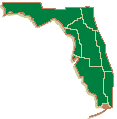
Bahia
Honda State Park
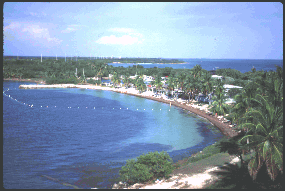
(Aerial photo above courtesy of Bahia Honda.)
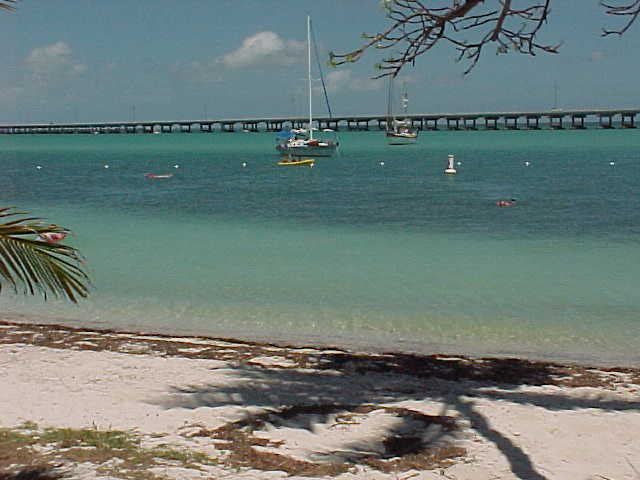
Bahia Honda State Park
and Recreation Area is located at Mile Marker 37. With its white sand
beaches and abundant wildlife, Bahia Honda Key frequently makes the list of the
top beautiful beaches in America. Here we are anchored in between the
bridges (you can see only the new bridge (Overseas Highway) in the shot below.
It's a glorious anchorage. You can see the beach swimming area roped off
and how close September Sea is to it.
Someone is puttering by in
a yellow inflatable dinghy.
This next photo you are
looking at Overseas Highway in the background (Overseas Highway divides
the Atlantic from the Gulf of Mexico). Friends Chris and Yanni aboard s/v
Magus are shown behind us at left. We really have a wonderful time at
Bahia Honda. There is a huge State Park, RV Park, Shower facilities, BBQ grills
and picnic tables right on the beach on which to stir up something tasty, and a
roped off swimming area, and people in the water enjoying their day. It's
just a breathtakingly lovely place.
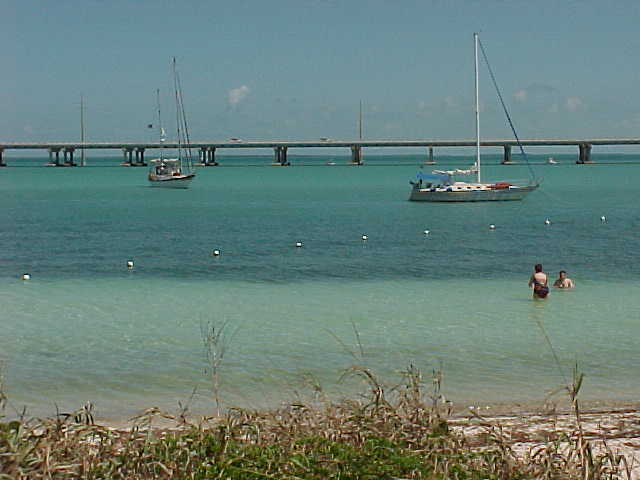
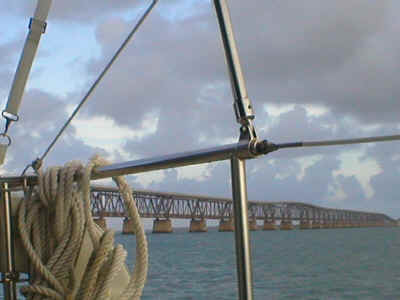
Above, a picture of the
old bridge, as seen through our aft cockpit. Flagler's Masterpiece.
Water vessels come from the Atlantic side through an opening of the bridge.
This bridge is no longer in use, as it was replaced by the Overseas Highway
Bridge. Below, the entrance to and exit from Bahia Honda for sailing
vessels.

The center where Bahia Honda is located, in between the bridges,
is still the Atlantic. Once you cross under the Overseas Bridge, you are
on the Gulf (of Mexico) side. It's really a special place where you have two
glorious bodies of water within a stone's throw of one another. It really
is a lovely place.




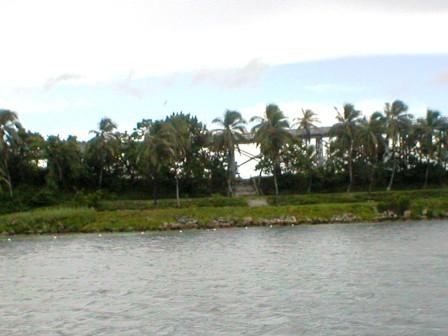
This area has steps so you
can walk up and on the old bridge. We've seen people jump from the old
bridge down into the water. I'd not recommend it as sport. The water
around the bridge is shallow... and bull sharks love to hang out there right
under the bridge. We've snorkeled here and never had a problem, and the
beach is nearby too. However, it is not recommended that one swims or
plays in the water directly beneath the bridges. Lots of people fish there
and the bull sharks have learned they can get a lazy meal just by waiting for a
fish to be hooked. Then, as you're pulling the fish in, you're often lucky
to be left with anything after the bull sharks get hold of it.
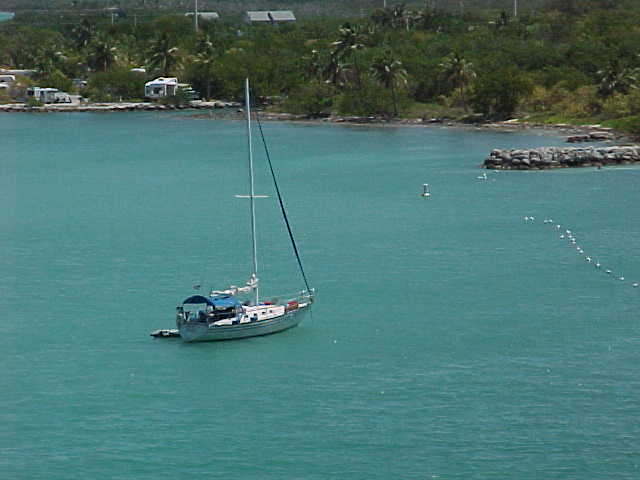
Above & Below: Anchored
out in Bahia Honda Paradise.
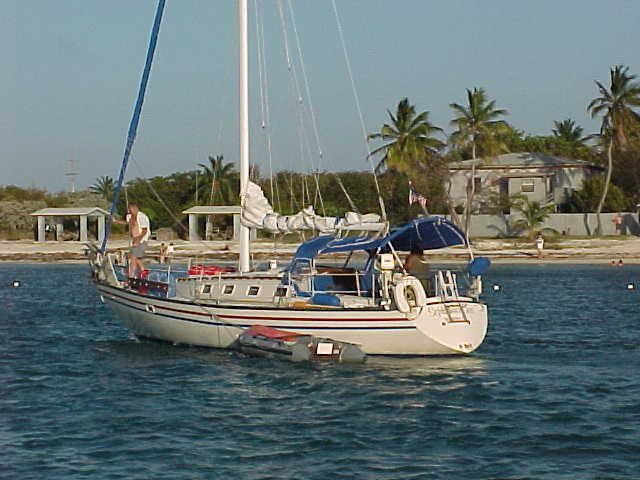
Does it get any better
than this? I must say... well... yeah, it DO. Ridiculous, huh?
Our sail flaking looks
terrible in the photo above, but trust me--it's the angle! This She-Captain would never allow
her sails to look ratty! Bill does a great job via a few lessons when
we first came down here, from our dear friend Sir Charles, who is (hands down)
-- King of the Flaked Sails.
The Keys are known for
their beautiful sunsets. What other place has the sun rising on one ocean
and then setting on yet another? Just spectacular sunsets. Such
beauty the whole world should know. If you haven't, you must get down here
to the Keys!
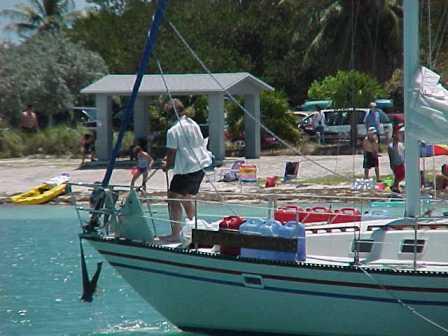


September Sea preparing to leave the
anchorage after staying there a couple of days and nights. Above left,
Bill pulls up the anchor.
Anchoring at Bahia Honda:
| Name |
kim bradford |
| Date |
Feb 08, 2009 |
| Location |
 |
| Message |
kim again...

I was trying to get some info on Bahia Honda state park. I called the
park and they said that holding was VERY bad in the park. I guess two
sailboats went aground during a storm that blew through??? My captain..
Ray... has been sailing for 30 years, so I dont think we would have a
problem. Hes a (dive over and check the anchor) kinda guy, but was
wondering about your advice. I saw your pics and we are extrememly
excited about our sail there in April... the marina has a controlling
depth of 3 1/2 feet so thats a no go for us.... we like to anchor out
anyway, but like to dinghy to shore for the laundry stuff.. any
suggestions???
Kim Bradford


Charmaine's Reply: ________________________________________ !
Hi there Kim, The potential problems with Bahia Honda is that you anchor
in between two bridges (the old railroad bridge and the new highway
bridge). You can imagine what could happen in a big blow... with no
where to go. It's not a very large area inside the two bridges.
The holding in Bahia Honda is comparatively poor to other areas in the
Keys; but stay near the swimming buoys and there is plenty of sand and
grass for your anchor to take hold.
Most of the people we have known who have dragged did so because they
anchored in the wrong areas there. Otherwise, you should do fine. When
backing down on the anchor (with about 30 ft. of rode out), once you
feel it grab, give it another good, quick tug revved around 3000 RPMs.
When the bow pushes DOWN with a resounding jerk... you know you're set
tight. After that, let out the remainder of your rode and have a Mojito.
The "gust" that came through here the other night was a 60+ knot wind
that was sustained for at least five minutes. So, in all fairness, many
anchors would have dragged with such a wind as the other night. You
would have to really been dug in. However, I'd guarantee you that my
Spade anchor would not have budged.
Hope this helps. You'll love Bahia Honda. It has lots of places to walk
to... you can dinghy around to the marina and tie up at the store there,
get water, etc. Just don't dinghy up to the beach as it is not allowed.
One other note: Watch the entrance carefully as there is a shoal (island
with a tree) right before the entrance and it's hard to see from a
distance. It's marked on your charts but in real life it can sneak up on
you. Stay to the western side of the entrance as you approach and you'll
be just fine.
Big Hugs, Charmaine |
Anchoring: Bahamian Moor
From: Sam Densler
Date: 05/29/09 20:28:32
To: Charmaine
Subject: Re: SW Florida
Thanks for the great info. We would love to meet you on our way
through.
One more question. The chart books recommend a Bahamian Moor when
anchoring in the Keys. We have never done that, always just 1 anchor.
Do you find it necessary and if so, what method do you use?
thanks,
Sam
May 31, 2009
Hi Sam,
A Bahamian moor is not a bad idea for this area because the biggest problem
with using two anchors is that as the current turns your boat round and
round your anchor rodes will twist together and cinch you too far up to your
anchors. When this happens, someone else may come in to anchor and anchor
way too close to you, not realizing your scope isn't even out until you
untwist and suddenly you are 50 ft. closer to them than when they came in.
You see what a problem that can be.
By the same token, when you wish to anchor in a frequented area (say, inside
the Harbor) note the anchor rodes of the boats around you. If they are
twisted up then you have no way of knowing where that boat will settle once
it untwists. Stick near boats that either only have one anchor out or that
otherwise show no sign of twisting (which means either they use the Bahamian
moor or they are dilligent in keeping their rodes untangled).
With the Bahamian moor it limits your arc when swinging and when you do
twist with the currents it will untwist on its own because of the pull
between the two anchors in this particular arrangment. Too, instead of
swinging the full length of your scope you will only swing nearer to the
actual length of your vessel. The Bahamian moor is very excellent for using
to take advantage of a tight spot others will pass on and look elsewhere for
more room.
I looked up the best explanation of the Bahamian moor technique and have it
printed below. I would recommend setting your kedge (second) anchor with
your dinghy and retrieving it with your dinghy as well. Makes it all so
much easier and more manageable. Be sure to follow the instructions to the
letter or it won't be effective. The great thing too, which the article
really doesn't explain, is that with the two anchors in opposite directions
you won't have to worry about one pulling out with a change in tide
direction or sudden wind shifts.
This time of year we have squalls that come up rather quickly. September
Sea has no need for using two anchors as her anchor is a 44 lb. Spade (Spade
is the brand name, not to be confused with anchors that simply look
spade-like) that digs to China and has successfully held us in place in over
60 knots without moving an inch. It also will not pull out no matter what
direction the boat swings or pulls. Its anchor will only free up when the
bow is driven forward overtop and beyond it with substantial power. That
scenario could never happen in a blow. The Spade anchor is worth its weight
in gold to me. After it is set, I simply forget about it. It's security is
akin to being tied to a mooring ball. I give tips on setting an anchor
under "Adventures" select "Bahia Honda" to read.
A note of caution: I do not recommend Danforth anchors for the Keys. They
let go in a blow and will find it quite difficult to reset and hold you.
Especially if you are in a high profile trawler. The more windage you have
the anchor holding you need. People often buy anchors for fair weather not
realizing they need to purchase a storm anchor. No one ever went topside
and put out a storm anchor in the middle of a blow...too late! So start out
with the biggest baddest anchor you can physically handle and that is your
every day anchor: sun, rain, or storm. Then it is there and in place
working for you when you NEED it.
The Bahamian Moor:
Strictly and traditionally speaking, to moor is to secure a boat with two
anchors whose rodes lead in opposite directions, or nearly so. A boat is not
moored when she lies to one anchor only, or even to two anchors lying ahead;
she is then at anchor. (In modern parlance, mooring connotes any
semipermanent anchoring system.) If you’re planning to leave your boat
unattended for a while in an anchorage, both you and she will be happier if
she’s moored. Some insurance policies will cover your boat if she’s moored
but not if she’s at anchor, so be sure you understand the difference. To
begin the Bahamian moor, set out your bower anchor—your largest working
one—in the direction of the prevailing wind or the strongest current. Drift
back to the full extent of the anchor line, and drop your kedge anchor. Then
haul in on the bower line, snubbing the kedge as you go to set it into the
ground, and center the boat between the two anchors. Now make the end of the
kedge line (usually nylon) fast with a rolling hitch to the bower rode
(chain or nylon). Ease away the bower rode from the bow roller until the
kedge line is well underwater—deep enough not to foul your keel when the
boat swings.In effect, you are now made fast by the bow to a line stretched
between two anchors, and the advantages are that your swinging circle is
greatly restricted and your rodes cannot foul their anchors.In practice,
don’t try to make an absolutely taut line between the two anchors. Leave
some slack so that when the wind comes from abeam, the rodes will lie to
windward in a shallow V shape and relieve the anchors of considerable
strain. Incidentally, it’s not always as easy as it sounds to join the kedge
line to the bower line. The longer the length of kedge line above water, the
more awkward it is to work with. It’s easier if you work the spare line into
a tight coil and lash it with a light line to prevent its unraveling before
you try tying the rolling hitch and submerging it.If you have a dinghy,
simply anchor with the bower from the bow on a scope of 5 to 1 or so, and
take the kedge aft in the dinghy to the full extent of its rode. Then tie
the inboard end of the kedge rode to the bower rode and lower the join into
the water as before, leaving the boat to swing freely from one rode passing
over the bow roller.When it’s time to leave, if you can’t recover the kedge
with the dinghy, buoy the end of the line and throw it overboard. Weigh the
bower anchor as usual, and then recover the kedge from your boat.
Bill and I look forward to meeting you and Gina.
I'm here for ya!
Big Hugs,
Charmaine
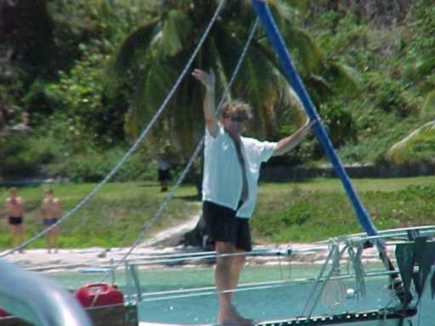
Bill waves: "Bye for now,
but we'll be back soon!"










